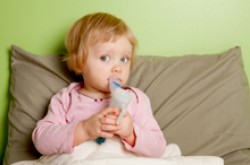Cystic Fibrosis Therapy Tested in Young Children
Cystic Fibrosis Therapy Tested in Young Children
A treatment that benefits adults and older children with cystic fibrosis may not help infants and young children with the disease, a new study reports. The finding could slow the adoption of this therapy in younger children.

Cystic fibrosis is an inherited disorder that results in a buildup of thick and sticky mucus in the lungs, airway and other organs. Excess mucus in the lungs can lead to coughing, breathing problems, scarring (fibrosis) and an increased risk of lung infections. The disorder affects about 30,000 people in the U.S. and 70,000 worldwide. There is no cure, but treatments can improve both the length and quality of life for people with the disease.
Previous studies have found that inhaling a concentrated salt water (hypertonic saline) mist provides some benefits to adults and older children with cystic fibrosis. The mist appears to loosen the thick mucus that builds up in the lungs, which may help reduce recurrent infections known as pulmonary exacerbations. The infections are thought to contribute to the lung damage and respiratory failure associated with cystic fibrosis.
Because of these earlier findings, the use of hypertonic saline in younger children has been rising. The therapy is now used by about 1 in 5 children under 6 years old with cystic fibrosis. But there isn’t clear evidence that the therapy is effective for these young children.
To test whether inhaling hypertonic saline helps young children with cystic fibrosis, a research team led by Dr. Margaret Rosenfeld at Seattle Children’s Hospital and Dr. Felix Ratjen at the University of Toronto enrolled 321 participants, ages 4 months to 60 months, at 30 cystic fibrosis care centers across the United States and Canada. Twice daily for 48 weeks, the children inhaled either 7% hypertonic saline or a 0.9% saline mist as a control. The study was sponsored by NIH’s National Heart, Lung and Blood Institute (NHLBI) and by the Cystic Fibrosis Foundation Therapeutics, Inc.
The scientists reported in the Journal of the American Medical Associationon June 6, 2012, that hypertonic saline was well-tolerated and caused few side effects. However, there was no difference between the 2 saline groups in the rate of acute lung problems that required treatment with antibiotics (an average of 2.3 cases per participant per year). The treatment also didn’t improve other clinical measurements such as coughing, respiratory rate, height or weight (the disorder can stunt children’s growth).
“Even reasonably simple and non-toxic therapies can be burdensome, especially for families of small children with a chronic disease such as cystic fibrosis,” says NHLBI Acting Director Dr. Susan Shurin. “This is one more study that illustrates the importance of conducting clinical research in children because medicine is not one size fits all—therapies that benefit adults or even teenagers do not always benefit younger children in the same way.”
The researchers note that hypertonic saline treatment might still help younger patients. Early lung damage associated with cystic fibrosis often shows no clinical symptoms. Whether this treatment might slow the progression of airway damage in infants and toddlers, resulting in better lung function later, isn’t yet known and will require further study.
###
* The above story is reprinted from materials provided by National Institutes of Health (NIH)
** The National Institutes of Health (NIH) , a part of the U.S. Department of Health and Human Services, is the nation’s medical research agency—making important discoveries that improve health and save lives. The National Institutes of Health is made up of 27 different components called Institutes and Centers. Each has its own specific research agenda. All but three of these components receive their funding directly from Congress, and administrate their own budgets.




















